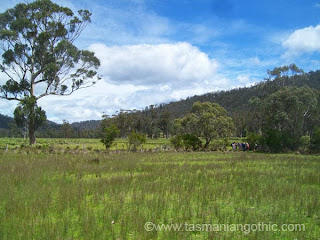Every place-name has a
story behind it. It may be a nostalgic transplant from the Old
Country; it may commemorate somebody who seemed important at the
time, or it might refer to the place itself, its distance from
somewhere else, the opinion of the person who named it, or a singular
feature.
The history of European
activity in Tasmania is brief by world standards, and there are
relics from some of the earliest days dotted around the state in all
sorts of unlikely places. However, you do often need expert advice to
confirm whether an overgrown pile of rocks constitutes significant
remains or merely a failed garden feature.
Nobody gets a prize for
guessing why Whalers' Lookout is so named, nor for guessing that it
is a prominent feature. And I was lucky enough to have Barry Ford
with me when I walked out there. Barry has been walking and camping
in the area for more than half a century and is generous in sharing
his knowledge.
The walk is across
private property, so the landowner's permission is required before
you start.
 |
| first glimpse of Cape Bernier (distance, centre) |
 |
| High Yellow Bluff on the Forestier Peninsula is in the background |
 |
| and a nice view of Maria Island |
 |
| That's where we're going - Whaler's Lookout is the closest bit of Cape Bernier |
Boot Bay
 |
| Boot Bay |
Police officers were once stationed here to guard the East Coast against
smugglers. There isn't much to see now, but there are plenty of
sheltered little bays where it would be easy for nefarious persons to
bring ashore things they shouldn't.
Wild flowers
Wild flowers are
glorious at this time of year. Yellow pea-flower, flag lilies, and
this white flower whose name I don't know. I just paint stuff; I
don't have to know what it's called.
Ruins
Once upon a time there
were several Youth Hostels along this coast, situated a comfortable
day's walk apart. This one burned down in a bushfire in the late
1950s. The next one along was at Bream Creek; I don't know whether
it's still there, but I shouldn't think it is.
The Whalers
Long before it became unfashionable this was the location of one of several whaling
stations. Whales were so plentiful along the Tasmanian coast that
crews rowed out from the shore to hunt them, and there were other
on-shore stations at Adventure Bay and Trumpeter Bay on Bruny Island
as well as several up the East Coast. It only took a few years to cut
numbers so drastically that the stations closed down and the whalers
had to put out to sea again.
 |
This trench was a slide
where whales were dragged ashore for processing.
It was originally brick-lined; there are still a few old bricks lying about (below). |
 |
Some overgrown piles
of rocks scattered through the bush
are all that is left of the station buildings. |
Fishermen and others
often come ashore here, and somebody had left not long before we
arrived; the ashes from their camp fire were still warm. They'd left
this little arrangement on a stump by the fire.
 |
Mercury Passage and
Whaler's Lookout from near the site of the Youth Hostel
|
I don't know how the
chap on the lookout communicated with his mates at the whaling
station; he may have shouted very loudly, or perhaps he just ran
back down as fast as he could go. At any rate, I imagine there was
much rushing to the boats when the signal was given that whales had been spotted.
There is just as much
excitement today about whales in the Mercury Passage, but
nobody is going to hunt them now.
Whaler's Lookout
Between the whaling
station and the lookout is the entrance to Cockle Bay Lagoon, which must have caused
some inconvenience at times. We were fortunate the tide was well out,
so we could cross easily, but this is not always the case and on
previous visits I have had to walk right around the lagoon and tackle the hill from the other end.
We much
prefer to make a circuit, up one side of Whaler's Lookout and down
the other.
 |
| going up |
"Up" from
this direction is an abrupt gravelly ascent through a lot of
inhospitably prickly wattle to the top of the lookout. But the view from the top is well worth the trouble. We spent a little time there, picking off leeches and eating our lunch.
The view.
Barry says the remains of a World War II observation post can still
be seen on top of Cape Bernier, should you be energetic enough to
scramble up there to look. I'm told it's pretty rough going, so I'll
just take his word for it.
After lunch we went down the other side.
 |
| and down again |
 |
| Whaler's Lookout from the inland side |
We circumnavigated the lagoon, then revisited all these places on our way home.
 |
Maria Island and Cockle
Bay Lagoon
|
With many thanks to Barry Ford for answering all my questions.















No comments:
Post a Comment